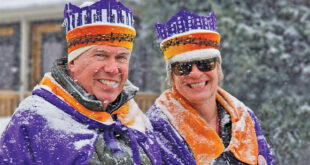Local family takes lasting gift to poorest state in Mexico
A small fire crackled above the dirt floor and sun shone through the wood plank walls in Fidelia Perez Gomez’s small hut in the village of La Virginia, high in the mountains of Chiapas, Mexico. It was Christmastime, but no light-trimmed trees or festive decorations adorned the home. The gifts being offered, however, would change lives.
In just a few short days, a small army of volunteers with the non-profit Foundation Escalera would leave the villagers with a new four-classroom, two-bathroom junior high school, providing a chance to improve education and the opportunities it can bring. They’d also provide many modern stoves that would take harmful wood smoke out of village homes.
Among the volunteers was Crested Butte’s Scott Howard, a political consultant who had been looking for a chance to see his donations at work. “For me, when I’m giving, I want to know that it’s actually going to the people I want it to go to and not in somebody’s pocket,” he says. Scott and his wife, Sarah, a photographer, heard about Escalera from their brother-in-law, Jon Neiporte, who had been working with the foundation for several years before becoming the organization’s president. The stories he brought back made everyone want to sign up.
But with five kids, the youngest aged three, a family trip to remote Mexico for the Howards wasn’t feasible, so plans were made for Scott to make the trip alone. On arriving in the centuries-old Mexican city of San Cristobal after a half-day of travel, Scott met his team of 25. They came from all walks of life but shared an eagerness to make a difference.
There was Carlo Garcia, a 27-year-old actor from Chicago who sells tickets for Ticket Master at his day job and does “‘living philanthropic” every chance he gets, giving the only resource he has in abundance: himself. While he waited for his big break in show business, Scott says, Garcia committed himself to donating to a cause every day of the year. His trip to Chiapas was the capstone to his effort.
Other members of the team included a vice president for Wal-Mart who had taken his family on the expedition, along with a city councilman from Utah. The people, the village and the purpose for going were all unlike anything Scott had ever been a part of and he wanted his family to share the experience.
A year later, Sarah took their two oldest daughters, Mercedes and Mabel, ages 10 and 8 respectively, to Nichnamtic, a similarly situated town in Chiapas, continuing a tradition of giving to some of the poorest people on the continent. “It was fun to help build the stoves,” Mercedes says. “It was also hard.” Building a six-classroom school and installing dozens of stoves in just a few days wouldn’t be easy, but it would pay off in spades.
“If these kids can successfully complete a junior high education they see their employment opportunities grow, because the difference between having an elementary and junior high education is huge,” Scott says. “But also, a lot of these kids go on to high school, which is important because it’s usually outside the village. It’s an amazing opportunity if they can get to that point. But they can’t get there without the junior high.”
According to the Center for Global Development, people in many developing countries like Mexico can increase their income by 10 percent for every year of schooling they complete beyond the elementary level. And while the Mexican government mandates children between nine and 18 attend some sort of school, UNESCO estimates 72 percent of appropriately aged children attend a secondary school in that country. Only a third of children who attend elementary school nationwide will graduate from high school. And in Chiapas, where more than half of the adults are illiterate and 63 percent never even get a primary-level education, the data doesn’t apply. “It made me sad that the kids don’t get to do a lot of fun stuff,” Mabel remembers. “They have to work all day.”
“In my village, there were three buildings that were just cinderblock shells, completely unfinished, and according to the villagers, the government had been working on those three school buildings for three years,” Scott says. “Then we came in and in one week built a school.” It is the only secondary school in town.
“I was surprised they only got six classrooms when they have like 400 students,” Mercedes, a fifth grader at Crested Butte Community School says. “We have three classrooms and only 50 students.”
The people of La Virginia—and also Nichnamtic where Sarah, Mercedes and Mable went—are indigenous Mayans who speak native dialects, not Spanish. Some elders, they said, weren’t even able to communicate with people outside the village. As a result the government often ignored them and the villagers went without basic services enjoyed in other parts of the country, adding an element of racism, they said.
“I think they were just appreciative of the fact that someone was willing to come in and help them help themselves,” Scott says.
One of Escalera’s objectives is finding communities that need standard of living improvements and are willing to invest in their own success. The foundation will find local tradesmen to pour a foundation in preparation for the arrival of the volunteers and then the local people will pitch in to help construct the modular school buildings. In just three days, Scott’s team was able to build a four-classroom school while Sarah and the girls’ “Epic Expedition” put up six classrooms and a basketball court.
“There were a lot of things that the foundation had filtered through to make sure the village wanted us there so when we left, the school and the stoves would be used,” he says.
Scott was part of one of the first groups to immerse themselves in the local culture, staying with a host family, eating the local fare and, in Scott’s case, trying to piece together bits of the local language. Sarah and the girls did the same the following year.
“You kind of become a part of what they are doing and then you’d go and help with the school,” Sarah says.
Some of what the people would do each day demonstrated to the Howards how close their lives came to subsistence living. “They’re living off the land, using firewood for heat and food and while they have electricity and cell phones, that’s it,” Sarah says. “Their way of life is so archaic, with only little snippets of electricity here and there, no running water or major public systems in these little villages on the outskirts of the larger cities.”
Fidelia Perez Gomez, with whom Scott stayed, was an older woman who would spend the first few hours of her day gathering wood to keep the fire burning, letting only as much touch the flame as was necessary. The woman spent longer each day gathering wood, as she had to walk farther in search of fuel.
“The amount of wood that they consume to cook over an open fire is enormous and it’s depleting the natural resources,” Scott said.
But, according to a report from the University of California and Princeton University, there are more than two billion people around the world who cooked their breakfast on an open flame this morning, if they cooked or ate at all. And the health impacts on people living with an open fire are grave.
In the report, the authors explain that homes where open fires are used for heat and cooking can have as much as 10,000 micrograms of airborne particles per cubic meter. The Environmental Protection Agency recommends people avoid exposure to air with 150 micrograms per cubic meter for more than 24 hours.
In the village where she stayed, Sarah says, “There’s lots of cancer and adolescent development problems because of the open smoke. And there’s just a real lack of medical care. We met a young woman who had a baby who was sick and there was no one she could go see—there was no modern medicine, there was nothing available to her. That was her second child. The first one had already passed away.”
According to the university report, when modern stoves are used with charcoal, indoor airborne particles can be cut by more than a factor of 10 and reduce respiratory illness by nearly half.
Based on similar studies that have been published over the last two decades, Escalera, which is named after the Spanish word for ladder, has been installing stoves alongside their work building 26 classrooms benefiting some 14,883 students in impoverished rural areas of Chiapas since 2000. It’s an opportunity to expand on their message of self-improvement.
And they’ve already got the next generation seeing the value in education. Mercedes and Mabel are already making plans to raise $500 for next year’s school-building project by setting up hot chocolate and lemonade stands, asking other people for used toy donations to sell with their own toys online, making crafts to sell, and holding bake sales and a bike-a-thon.
“I think if you look at education, that is the thing that will have the long-term impact. With welfare needs, you can take care of people by feeding them, clothing them and housing them. But in the long term, I don’t think you make a cultural and generational change without some significant game changer and I think that’s education,” Scott says. “You have to give people a way to provide for themselves.”
 The Crested Butte News Serving the Gunnison Valley since 1999
The Crested Butte News Serving the Gunnison Valley since 1999



